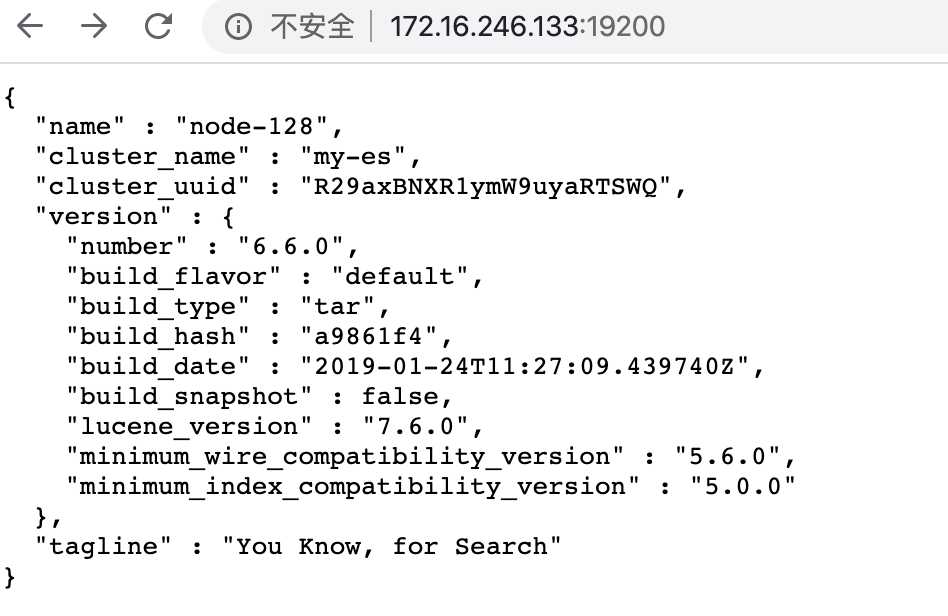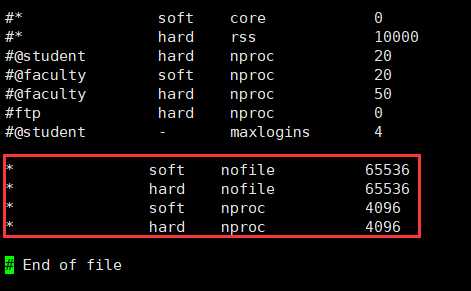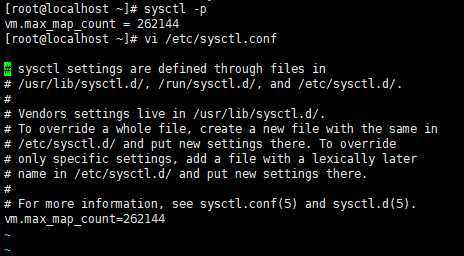标签:lease modprobe 查询 nes struct effective etc ase eps
1.服务器准备:centos7.4系统,Jdk1.8 cat /etc/redhat-release。Es6.x
如果是自带的openjdk需要先卸载:
rpm -qa|grep java
rpm -e –nodeps *

2.ElasticSearch安装:我采用的版本为6.6.0 https://elasticsearch.cn/download/
(1)地址:https://artifacts.elastic.co/downloads/elasticsearch/elasticsearch-6.6.0.tar.gz
(2)解压:tar -zxvf elasticsearch/elasticsearch-6.6.0.tar.gz
(3)修改系统配置:
添加如下内容:
fs.file-max=65536
vm.max_map_count=262144
sysctl -p 刷新下配置,
sysctl -a查看是否生效 ,
如果不成功的(启动es还是失败,不是所有人都碰得到,好像是在7.6碰到了):
rm -f /sbin/modprobe ?
ln -s /bin/true /sbin/modprobe
rm -f /sbin/sysctl
?ln -s /bin/true /sbin/sysctl
设置资源参数
vi /etc/security/limits.conf
# 添加一下内容:
* soft nofile 65536
* hard nofile 131072
* soft nproc 2048
* hard nproc 4096
修改进程数
vi /etc/security/limits.d/20-nproc.conf
* soft nproc 4096
配置完成后 要关掉链接窗口,重新打开一个
不能用root用户启动
修改es配置文件: vim elasticsearch安装路径/config/elasticsearch.yml
# 配置es的集群名称, es会自动发现在同一网段下的es,如果在同一网段下有多个集群,就可以用这个属性来区分不同的集群?
cluster.name: bi-cluster
# 节点名称
node.name: node-master
# 存储数据的目录
path.data: /home/elasticsearch/data
# 存储日志的目录
path.logs: /home/elasticsearch/logs
# 设置绑定的ip地址还有其它节点和该节点交互的ip地址
network.host: 0.0.0.0
# 指定http端口,你使用head?kopf等相关插件使用的端口
http.port: 9200
# 设置节点间交互的tcp端口,默认是9300
transport.tcp.port: 9300
#设置集群中master节点的初始列表,可以通过这些节点来自动发现新加入集群的节点?
discovery.zen.ping.unicast.hosts: ["10.108.4.203:9300", "10.108.4.204:9300", "10.108.4.205:9300"]
#如果没有这种设置,遭受网络故障的集群就有可能将集群分成两个独立的集群 - 分裂的大脑 - 这将导致数据丢失
discovery.zen.minimum_master_nodes: 3
http.cors.enabled: true #es5.x版本以上需要,head访问
http.cors.allow-origin: "*"
bootstrap.memory_lock: false #某些系统需要 是因为centos6.x操作系统不支持SecComp,而elasticsearch 5.5.2默认 bootstrap.system_call_filter为true进行检测,所以导致检测失败,失败后直接导致ES不能启动。
我的配置如下:
# ======================== Elasticsearch Configuration ====================
=====
#
# NOTE: Elasticsearch comes with reasonable defaults for most settings.
# Before you set out to tweak and tune the configuration, make sure y
ou
# understand what are you trying to accomplish and the consequences.
#
# The primary way of configuring a node is via this file. This template lis
ts
# the most important settings you may want to configure for a production cl
uster.
#
# Please consult the documentation for further information on configuration
options:
# https://www.elastic.co/guide/en/elasticsearch/reference/index.html
#
# ---------------------------------- Cluster ------------------------------
-----
#
# Use a descriptive name for your cluster:
#
#cluster.name: my-application
#
# ------------------------------------ Node -------------------------------
-----
#
# Use a descriptive name for the node:
#
#node.name: node-1
#
# Add custom attributes to the node:
#
#node.attr.rack: r1
#
# ----------------------------------- Paths -------------------------------
-----
#
# Path to directory where to store the data (separate multiple locations by
comma):
#
#path.data: /path/to/data
#
# Path to log files:
#
#path.logs: /path/to/logs
#
# ----------------------------------- Memory ------------------------------
-----
#
# Lock the memory on startup:
#
#bootstrap.memory_lock: true
#
# Make sure that the heap size is set to about half the memory available
# on the system and that the owner of the process is allowed to use this
# limit.
#
# Elasticsearch performs poorly when the system is swapping the memory.
#
# ---------------------------------- Network ------------------------------
-----
#
# Set the bind address to a specific IP (IPv4 or IPv6):
#
#network.host: 192.168.0.1
#
# Set a custom port for HTTP:
#
#http.port: 9200
#
# For more information, consult the network module documentation.
#
# --------------------------------- Discovery -----------------------------
-----
#
# Pass an initial list of hosts to perform discovery when new node is start
ed:
# The default list of hosts is ["127.0.0.1", "[::1]"]
#
#discovery.zen.ping.unicast.hosts: ["host1", "host2"]
#
# Prevent the "split brain" by configuring the majority of nodes (total num
ber of master-eligible nodes / 2 + 1):
#
#discovery.zen.minimum_master_nodes:
#
# For more information, consult the zen discovery module documentation.
#
# ---------------------------------- Gateway ------------------------------
-----
#
# Block initial recovery after a full cluster restart until N nodes are sta
rted:
#
#gateway.recover_after_nodes: 3
#
# For more information, consult the gateway module documentation.
#
# ---------------------------------- Various ------------------------------
-----
#
# Require explicit names when deleting indices:
#
#action.destructive_requires_name: true
cluster.name: my-es
node.name: node-128
network.host: 0.0.0.0
http.port: 19200
transport.tcp.port: 19300
#discovery.zen.ping.unicast.hosts: ["127.0.0.1:9300"]
#discovery.zen.minimum_master_nodes: 3
http.cors.enabled: true
http.cors.allow-origin: "*"
bootstrap.memory_lock: false
bootstrap.system_call_filter: false
启动es:./bin/elasticsearch 后台启动加 –d参数
打开浏览器访问 http://你的ip:19200/查看是否能够正常访问,看到以下界面表示启动ok

如果在外网访问失败的话,请按照以下步骤执行:
network.host: 0.0.0.0
bootstrap.memory_lock: false bootstrap.system_call_filter: false
开启、重启、关闭、firewalld.service服务
# 开启
service firewalld start
# 重启
service firewalld restart
# 关闭
service firewalld stop
查看防火墙规则:
firewall-cmd --list-all
查询、开放、关闭端口:
# 查询端口是否开放
firewall-cmd --query-port=8080/tcp
# 开放80端口
firewall-cmd --permanent --add-port=80/tcp
# 移除端口
firewall-cmd --permanent --remove-port=8080/tcp
#重启防火墙(修改配置后要重启防火墙)
firewall-cmd --reload
ulimit -Hn ulimit -Sn
修改/etc/security/limits.conf文件,增加配置,用户退出后重新登录生效
* soft nofile 65536 * hard nofile 65536

(2)max number of threads [3818] for user [es] is too low, increase to at least [4096]
问题同上,最大线程个数太低。修改配置文件/etc/security/limits.conf(和问题1是一个文件),增加配置
* soft nproc 4096 * hard nproc 4096
可通过命令查看
ulimit -Hu ulimit -Su

修改后的文件:

如果更改后发现ulimit -Su 的结果没有变化的话,此时需要在这个文件中添加如下信息:(admin是我自己的用户名称,可以根据自己的实际用户更改)
admin - nproc 4096

max virtual memory areas vm.max_map_count [65530] is too low, increase to at least [262144]
修改/etc/sysctl.conf文件,增加配置vm.max_map_count=262144
vi /etc/sysctl.conf
sysctl -p
执行命令sysctl -p生效

4、Exception in thread "main" java.nio.file.AccessDeniedException: /usr/local/elasticsearch/elasticsearch-6.2.2-1/config/jvm.options
elasticsearch用户没有该文件夹的权限,执行命令
chown -R es:es /usr/local/elasticsearch/
1、将下载的kibana安装包解压: tar -zxvf kibana-6.6.0-linux-x86_64.tar.gz
2、更改kibana的配置
# Kibana is served by a back end server. This setting specifies the port to use. server.port: 15601 # Specifies the address to which the Kibana server will bind. IP addresses and host names are both valid values. # The default is ‘localhost‘, which usually means remote machines will not be able to connect. # To allow connections from remote users, set this parameter to a non-loopb ack address. #server.host: "localhost" server.host: "0.0.0.0" # Enables you to specify a path to mount Kibana at if you are running behin d a proxy. # Use the `server.rewriteBasePath` setting to tell Kibana if it should remo ve the basePath # from requests it receives, and to prevent a deprecation warning at startu p. # This setting cannot end in a slash. #server.basePath: "" # Specifies whether Kibana should rewrite requests that are prefixed with # `server.basePath` or require that they are rewritten by your reverse prox y. # This setting was effectively always `false` before Kibana 6.3 and will # default to `true` starting in Kibana 7.0. #server.rewriteBasePath: false # The maximum payload size in bytes for incoming server requests. #server.maxPayloadBytes: 1048576 # The Kibana server‘s name. This is used for display purposes. #server.name: "your-hostname" # The URLs of the Elasticsearch instances to use for all your queries. #elasticsearch.hosts: ["http://localhost:9200"] elasticsearch.hosts: ["http://localhost:19200"] # When this setting‘s value is true Kibana uses the hostname specified in t he server.host # setting. When the value of this setting is false, Kibana uses the hostnam e of the host # that connects to this Kibana instance. #elasticsearch.preserveHost: true # Kibana uses an index in Elasticsearch to store saved searches, visualizat ions and # dashboards. Kibana creates a new index if the index doesn‘t already exist . #kibana.index: ".kibana" # The default application to load. #kibana.defaultAppId: "home" # If your Elasticsearch is protected with basic authentication, these setti ngs provide # the username and password that the Kibana server uses to perform maintena nce on the Kibana # index at startup. Your Kibana users still need to authenticate with Elast icsearch, which # is proxied through the Kibana server. #elasticsearch.username: "user" #elasticsearch.password: "pass" # Enables SSL and paths to the PEM-format SSL certificate and SSL key files , respectively. # These settings enable SSL for outgoing requests from the Kibana server to the browser. #server.ssl.enabled: false #server.ssl.certificate: /path/to/your/server.crt #server.ssl.key: /path/to/your/server.key # Optional settings that provide the paths to the PEM-format SSL certificat e and key files. # These files validate that your Elasticsearch backend uses the same key fi les. #elasticsearch.ssl.certificate: /path/to/your/client.crt #elasticsearch.ssl.key: /path/to/your/client.key # Optional setting that enables you to specify a path to the PEM file for t he certificate # authority for your Elasticsearch instance. #elasticsearch.ssl.certificateAuthorities: [ "/path/to/your/CA.pem" ] # To disregard the validity of SSL certificates, change this setting‘s valu e to ‘none‘. #elasticsearch.ssl.verificationMode: full # Time in milliseconds to wait for Elasticsearch to respond to pings. Defau lts to the value of # the elasticsearch.requestTimeout setting. #elasticsearch.pingTimeout: 1500 # Time in milliseconds to wait for responses from the back end or Elasticse arch. This value # must be a positive integer. #elasticsearch.requestTimeout: 30000 # List of Kibana client-side headers to send to Elasticsearch. To send *no* client-side # headers, set this value to [] (an empty list). #elasticsearch.requestHeadersWhitelist: [ authorization ] # Header names and values that are sent to Elasticsearch. Any custom header s cannot be overwritten # by client-side headers, regardless of the elasticsearch.requestHeadersWhi telist configuration. #elasticsearch.customHeaders: {} # Time in milliseconds for Elasticsearch to wait for responses from shards. Set to 0 to disable. #elasticsearch.shardTimeout: 30000 # Time in milliseconds to wait for Elasticsearch at Kibana startup before r etrying. #elasticsearch.startupTimeout: 5000 [admin@localhost kibana-6.6.0-linux-x86_64]$ cat config/kibana.yml # Kibana is served by a back end server. This setting specifies the port to use. server.port: 15601 # Specifies the address to which the Kibana server will bind. IP addresses and host names are both valid values. # The default is ‘localhost‘, which usually means remote machines will not be able to connect. # To allow connections from remote users, set this parameter to a non-loopb ack address. #server.host: "localhost" server.host: "0.0.0.0" # Enables you to specify a path to mount Kibana at if you are running behin d a proxy. # Use the `server.rewriteBasePath` setting to tell Kibana if it should remo ve the basePath # from requests it receives, and to prevent a deprecation warning at startu p. # This setting cannot end in a slash. #server.basePath: "" # Specifies whether Kibana should rewrite requests that are prefixed with # `server.basePath` or require that they are rewritten by your reverse prox y. # This setting was effectively always `false` before Kibana 6.3 and will # default to `true` starting in Kibana 7.0. #server.rewriteBasePath: false # The maximum payload size in bytes for incoming server requests. #server.maxPayloadBytes: 1048576 # The Kibana server‘s name. This is used for display purposes. #server.name: "your-hostname" # The URLs of the Elasticsearch instances to use for all your queries. #elasticsearch.hosts: ["http://localhost:9200"] elasticsearch.hosts: ["http://localhost:19200"] # When this setting‘s value is true Kibana uses the hostname specified in t he server.host # setting. When the value of this setting is false, Kibana uses the hostnam e of the host # that connects to this Kibana instance. #elasticsearch.preserveHost: true # Kibana uses an index in Elasticsearch to store saved searches, visualizat ions and # dashboards. Kibana creates a new index if the index doesn‘t already exist . #kibana.index: ".kibana" # The default application to load. #kibana.defaultAppId: "home" # If your Elasticsearch is protected with basic authentication, these setti ngs provide # the username and password that the Kibana server uses to perform maintena nce on the Kibana # index at startup. Your Kibana users still need to authenticate with Elast icsearch, which # is proxied through the Kibana server. #elasticsearch.username: "user" #elasticsearch.password: "pass" # Enables SSL and paths to the PEM-format SSL certificate and SSL key files , respectively. # These settings enable SSL for outgoing requests from the Kibana server to the browser. #server.ssl.enabled: false #server.ssl.certificate: /path/to/your/server.crt #server.ssl.key: /path/to/your/server.key # Optional settings that provide the paths to the PEM-format SSL certificat e and key files. # These files validate that your Elasticsearch backend uses the same key fi les. #elasticsearch.ssl.certificate: /path/to/your/client.crt #elasticsearch.ssl.key: /path/to/your/client.key # Optional setting that enables you to specify a path to the PEM file for t he certificate # authority for your Elasticsearch instance. #elasticsearch.ssl.certificateAuthorities: [ "/path/to/your/CA.pem" ] # To disregard the validity of SSL certificates, change this setting‘s valu e to ‘none‘. #elasticsearch.ssl.verificationMode: full # Time in milliseconds to wait for Elasticsearch to respond to pings. Defau lts to the value of # the elasticsearch.requestTimeout setting. #elasticsearch.pingTimeout: 1500 # Time in milliseconds to wait for responses from the back end or Elasticse arch. This value # must be a positive integer. #elasticsearch.requestTimeout: 30000 # List of Kibana client-side headers to send to Elasticsearch. To send *no* client-side # headers, set this value to [] (an empty list). #elasticsearch.requestHeadersWhitelist: [ authorization ] # Header names and values that are sent to Elasticsearch. Any custom header s cannot be overwritten # by client-side headers, regardless of the elasticsearch.requestHeadersWhi telist configuration. #elasticsearch.customHeaders: {} # Time in milliseconds for Elasticsearch to wait for responses from shards. Set to 0 to disable. #elasticsearch.shardTimeout: 30000 # Time in milliseconds to wait for Elasticsearch at Kibana startup before r etrying. #elasticsearch.startupTimeout: 5000 # Logs queries sent to Elasticsearch. Requires logging.verbose set to true. #elasticsearch.logQueries: false # Specifies the path where Kibana creates the process ID file. #pid.file: /var/run/kibana.pid # Enables you specify a file where Kibana stores log output. #logging.dest: stdout # Set the value of this setting to true to suppress all logging output. #logging.silent: false # Set the value of this setting to true to suppress all logging output othe r than error messages. #logging.quiet: false # Set the value of this setting to true to log all events, including system usage information # and all requests. #logging.verbose: false # Set the interval in milliseconds to sample system and process performance # metrics. Minimum is 100ms. Defaults to 5000. #ops.interval: 5000 # Specifies locale to be used for all localizable strings, dates and number formats. #i18n.locale: "en"
3、启动kibana: ./bin/kibana

4、外网通过ip地址访问:

注意两个点:
(1)修改启动的es链接地址
(2)修改地址绑定不然只有本地才能访问
(3)kibana的版本和elasticsearch的版本必须一致,比如都是6.6
标签:lease modprobe 查询 nes struct effective etc ase eps
原文地址:https://www.cnblogs.com/yatou-blog/p/12113909.html